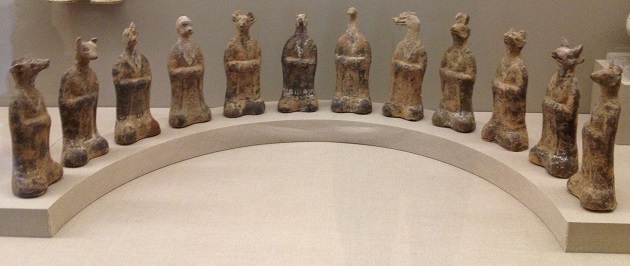
Unknown
Chinese, Northern dynasties - Sui dynasty
Twelve Zodiac Animals in Human Attire, 6th-7th c. CE
grey earthenware with traces of pigment
9 1/8 in. each
SBMA, Gift of the Joseph Haile Schaffner Estate
1973.85.1-12
COMMENTS
The Twelve Zodiac Animals from right to left:
RAT. The rat is seen as a symbol of industry and prosperity, because of its ability for locating and keeping plentiful supplies of food.
OX. The ox is the symbol of spring and farming. In China the yellow ox is the water buffalo, sturdy and muscular, who works hard at the plough and the mill. The Chinese regard the ox as sacred and powerful.
TIGER. The tiger symbolizes majesty and dignity, the model for the courage and fierceness of a soldier. The Chinese call the tiger the king of beasts on land (the dragon rules the seas).
HARE. The hare or rabbit is a symbol of long life. The hare is said to turn white when half of its thousand years of life are completed. The rabbit is associated with the moon because in Chinese legend it sacrificed itself and was taken into the moon.
DRAGON. The dragon is a strong and good spirit representing change and life itself. The dragon is the symbol of imperial power and is used to mark the emperor’s throne and all his possessions. It rules the seas and rivers and produces wind and rain to help mankind.
SERPENT. The serpent is quick and deadly in its strike, and the Chinese feel great respect for it. To purchase a captured snake and free it is a good deed which is rewarded. Fairies and demons can turn themselves into snakes.
HORSE. The horse is an emblem of speed and perseverance. A quick-witted youth is sometimes called a colt. Horses were ridden to battle or used to pull chariots.
SHEEP. The ram is the emblem of retiring life, of peace and just reward.
MONKEY. The monkey is a clever trickster. It bestows health and success on man by keeping away goblins and witches, which it controls, and which cause sickness and bad luck.
ROOSTER. The cock represents warmth and life. It is courageous and war-like, but also good-hearted (always clucking for the hens when it scratches up a grain), and faithful (never losing the hour). The Chinese believe it drives away ghosts when it crows at sunrise.
DOG. A dog’s coming means prosperity because it is smart when it selects a master. Dogs keep away from anyone who is not what he should be, and are watchful and loyal.
PIG. The pig, or wild boar, is even-tempered when left alone but can be fierce when cornered.
SBMA CURATORIAL LABELS
These twelve animals in human attire and stance (from right) - rat, ox, tiger, hare, dragon, serpent, horse, sheep, monkey, rooster, dog, and pig - are the same animals and order that we know today, representing each year in the traditional Chinese calendar. This group is rare in the complete number and early date. Animals played important roles as omens and portents in ancient beliefs. They were symbols of time as well as the directional points on a compass. These animals would have been placed in the tomb chamber, functioning as potent spirits of cosmic forces, presiding over time and space, ensuring safety and good fortune for the deceased in the afterlife.
